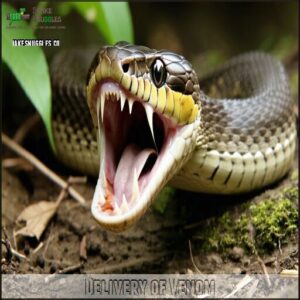This site is supported by our readers. We may earn a commission, at no cost to you, if you purchase through links.

They’re not fangs but rather small, needle-like structures perfect for gripping slippery prey like worms and amphibians.
While a garter snake might nip if you surprise it, their teeth rarely break skin. If they do bite, you’ll feel tiny pinpricks rather than serious punctures.
Their mild venom isn’t dangerous to humans but helps immobilize their dinner. Knowing about these harmless garden helpers and their dental equipment can make your backyard encounters much less nerve-wracking than you’d think, with complete confidence.
Table Of Contents
- Key Takeaways
- Do Garter Snakes Have Teeth?
- Garter Snake Bite Experience
- Understanding Garter Snake Teeth
- Potential Impact of Garter Snake Bites
- Tips for Handling Garter Snakes
- Coexisting With Garter Snakes
- Managing Garter Snake Presence
- Frequently Asked Questions (FAQs)
- Are garter snakes venomous?
- How do garter snakes behave around humans?
- Do garter snakes shed their skin?
- Do garter snakes have stripes?
- Are garter snakes have teeth?
- Are garter snakes toothless?
- Can a garter snake bite hurt a cat?
- Do garter snakes bite hurt?
- Why should you never pick up a garter snake?
- Can a garter snake bite hurt a dog?
- Conclusion
Key Takeaways
- Garter snakes have tiny, backward-curved teeth that help them grip slippery prey like worms and amphibians.
- Their teeth are small and not harmful to humans, causing only a mild pinch if bitten.
- Garter snakes are mildly venomous, but their venom is harmless to people and only effective on small prey.
- They prefer to escape rather than bite and only defend themselves when cornered or threatened.
Do Garter Snakes Have Teeth?
Yes, garter snakes absolutely have teeth! These common garden reptiles possess numerous tiny, needle-sharp teeth in both their upper and lower jaws—typically 20-30 in total.
Unlike the prominent fangs of venomous snakes, garter snakes have homodont dentition with three tooth types: recurved (shallow S-shape), curved (crescent), and linear. Their teeth feature dental ridges that create sharp, blade-like edges for better grip on slippery prey.
Garter snake teeth aren’t uniform in size; they’re smaller in front and progressively longer toward the back. This opisthoglyphous arrangement helps them secure wriggly meals like worms and amphibians.
What’s fascinating is their continuous tooth replacement cycle. When teeth break or wear down, new ones develop—a process called polyphyodonty in snakes. They also hibernate in groups during the winter months for warmth and protection.
While the rear teeth can deliver mild saliva toxins through venom grooves, don’t worry! Their teeth function primarily for prey gripping, not chewing, and pose virtually no threat to humans handling them.
Garter Snake Bite Experience
When you encounter a garter snake in your garden, knowing what to expect from a potential bite can ease your concerns.
A garter snake bite typically feels like a quick pinch or scratch – certainly not the intense pain associated with venomous species. Though garter snakes are technically mildly venomous, their venom potency is negligible to humans, causing little more than slight irritation in most cases.
Garter snake bites feel like quick pinches—their mild venom might surprise you, but won’t harm you.
Proper bite wound care is straightforward: wash with soap and water, apply antiseptic, and monitor for infection. Allergic reactions are extremely rare, but possible.
Most gardeners never experience a bite, as the snake bite frequency is low – these shy reptiles prefer escape over confrontation. They only bite when they feel cornered or directly threatened, making unprovoked attacks uncommon, and their behavior is generally characterized by a preference for avoidance, which is a key aspect of their shy nature.
Understanding Garter Snake Teeth
You’ll find that garter snakes possess small, curved teeth arranged in rows, with shorter ones in front and longer ones in back.
These specialized opisthoglyphous teeth help the snake grip slippery prey like worms and frogs, while the grooved rear teeth can channel mild venom into their meal, utilizing mild venom to aid in the process.
Structure and Function
After learning what a garter snake bite feels like, you might wonder about the teeth that caused those tiny punctures.
Garter snake teeth are masterpieces of evolutionary design—small but incredibly effective. When examining a garter snake’s mouth, you’ll notice 20-30 tiny teeth arranged in rows along both upper and lower jaws. These aren’t for chewing but serve as specialized gripping tools.
The tooth morphology of garter snakes includes three distinct types:
- Recurved teeth feature a shallow S-shape perfect for ensnaring slippery prey
- Curved teeth resemble crescent moons, helping manipulate food in the mouth
- Linear teeth have straight tips that easily penetrate prey’s skin
- Dental ridges create sharp cutting edges when jaws close
Their jaw flexibility allows these teeth to work together like miniature fishhooks, preventing escape once prey is caught. Through continuous tooth replacement, garter snakes maintain this efficient prey-gripping system throughout their lives.
This dental architecture is perfectly suited for their diet of frogs, worms, and fish—no dramatic fangs needed!
Delivery of Venom
Garter snakes possess a fascinating venom delivery system unlike their more dangerous relatives. Instead of prominent fangs, these garden residents use specialized rear teeth (opisthoglyphous teeth) that contain subtle venom channeling grooves.
When a garter snake bites, it doesn’t simply strike and release. You’ll notice it employs a distinctive chewing motion—this isn’t just poor table manners! The snake is actually working its mildly toxic saliva from Duvernoy’s gland into the wound.
Garter snakes pack a surprising secret: specialized rear teeth that deliver mild venom while gripping slippery prey.
Not dangerous to people
Don’t worry—while this system effectively immobilizes frogs and worms, it’ll cause nothing more than minor irritation to humans.
Potential Impact of Garter Snake Bites
After a garter snake chomps down on your skin, you’ll likely experience nothing more than a mild pinch. Their bite severity ranks incredibly low on the danger scale, with effects similar to a paper cut rather than a medical emergency.
If you do get bitten, here’s what to expect:
- Tiny puncture marks where their small teeth broke the skin
- Mild redness and slight swelling that typically fades within hours
- Minimal discomfort that feels like a light scratch
- In rare cases, mild itching around the bite area
Their mild venom affects small prey but won’t harm humans unless you’re among the extremely rare individuals with snake bite allergic reactions. Simply wash with soap and water, apply antiseptic to prevent infection risks, and you’re good to go.
First aid is straightforward—clean the wound and monitor for unusual swelling or redness that might indicate complications.
Tips for Handling Garter Snakes
When handling a garter snake, proper technique can be the difference between a pleasant encounter and a defensive bite. Despite their tiny teeth, respect for these garden helpers goes a long way in avoiding those pinprick nips.
For safe snake handling, consider the following guidelines:
- Support the snake’s body evenly, using a gentle mid-section grip (like holding a delicate taco without squeezing the fillings out)
- Move slowly and deliberately to prevent triggering their defense response
- Wear thin cotton gloves if you’re nervous, offering protection while maintaining dexterity
Always wash your hands thoroughly after handling to protect both you and the snake. To maintain their well-being, it’s essential to guarantee appropriate humidity levels in their enclosure, ensuring a healthy environment for these garden helpers.
Coexisting With Garter Snakes
You’ll find that creating a balanced yard ecosystem actually encourages these helpful reptiles to control pests without confrontation.
With their small teeth designed primarily for gripping prey like slugs and insects, garter snakes can become valuable garden allies rather than feared backyard residents.
Snake Safety for Pets
Keeping your four-legged companions safe from garter snakes requires vigilance. Though these slithery neighbors aren’t deadly to pets, prevention beats treating a snake bite on dogs every time!
Some owners also seek specialized snake aversion training for their dogs.
| Pet Safety Strategy | Why It Matters | Action Steps | Emergency Plan |
|---|---|---|---|
| Snake bite prevention | Prevents panic and vet visits | Keep yards clear of debris | Have first aid essentials ready |
| Pet snake identification | Knowledge is power | Learn to spot local species | Know symptoms of bites |
| Bite prevention training | Teaches pets to avoid snakes | Train "leave it" commands | Have vet emergency contact |
| Supervised outdoor time | Controls encounters | Keep pets leashed in high-risk areas | Know closest emergency vet |
Managing Snake Habitat
For effective garter snake habitat management, focus on making your property less attractive to these slithery visitors.
Keep grass mowed short to avoid attracting rodents – their presence inevitably leads to predators like garter snakes following close behind. Remove potential shelter spots by clearing debris piles, fallen logs, and dense vegetation near your home.
Consider food reduction strategies by eliminating standing water where amphibians breed and controlling insects and worms that serve as snake meals. You may also need to think about snake habitat products for more effective control.
Commercial repellents can provide temporary deterrence, though their effectiveness varies. If you’re encountering persistent snake issues, humane relocation options exist – just remember that garter snakes are beneficial predators that control pests naturally.
Creating this balance allows for safe human interaction with snakes while dispelling common snake misconceptions, and understanding the importance of garter snake habitat management is key to coexisting with these animals.
Managing Garter Snake Presence
While you’ve been learning how to peacefully coexist with these garden allies, you might still want fewer garter snakes around your property.
Managing their presence is straightforward once you understand their habits. Create an unwelcoming environment by removing debris piles, keeping grass short, and sealing foundation gaps that serve as snake highways.
Natural deterrents like coffee grounds, crushed eggshells, or snake-repelling plants (marigolds, lemongrass) can discourage unwanted visitors. Many homeowners also consider effective snake repellent to keep snakes away.
- For persistent snake issues, consider professional help from wildlife experts who can safely remove and relocate these beneficial but sometimes unwelcome reptiles.
Frequently Asked Questions (FAQs)
Are garter snakes venomous?
While they’re often considered harmless, garter snakes are actually mildly venomous.
You won’t need to worry though—their venom is too weak to harm you, only helping them subdue small prey like frogs and worms.
How do garter snakes behave around humans?
Garter snakes typically flee when they encounter you. They’re non-aggressive and only bite if you handle or corner them. When startled, they’ll slither away quickly, preferring escape over confrontation.
Do garter snakes shed their skin?
Every few weeks, garter snakes ditch their old skin like a kid outgrowing sneakers.
They shed to accommodate growth and remove parasites, peeling it off in one neat piece, kind of like turning a sock inside out, which is a process that helps them accommodate growth.
Do garter snakes have stripes?
You’ll notice garter snakes often have distinct stripes running along their bodies, usually in shades of yellow, white, or green.
These stripes help them blend into grassy habitats, making them sneakily hard to spot, with distinct stripes being a key feature.
Are garter snakes have teeth?
Yes, they’ve got teeth, but don’t worry—they’re tiny and not meant for harm.
These small, curved teeth help garter snakes grip slippery prey like worms and frogs, but they’re harmless to humans.
Are garter snakes toothless?
They’re not toothless—garter snakes have tiny, curved teeth designed for gripping prey.
While they lack scary fangs, their bite feels like a pinch.
Don’t worry, though—they’ll likely prefer escape over biting you!
Can a garter snake bite hurt a cat?
A garter snake’s bite likely won’t ruffle your cat’s fur much.
Their tiny teeth and mild venom are harmless to most pets, causing only minor irritation at worst.
Still, wash the area to prevent infection.
Do garter snakes bite hurt?
A garter snake’s bite doesn’t really hurt—it feels more like a scratch or tiny pinch.
Their teeth are small and not built for damage, so at worst, you might feel minor irritation or itching.
Why should you never pick up a garter snake?
You shouldn’t pick up a garter snake because it might bite or release a foul-smelling musk as a defense.
Although harmless, it’s best to admire them from a distance to avoid stress—for both of you, and this is crucial for mutual respect.
Can a garter snake bite hurt a dog?
A garter snake bite can cause mild discomfort to your dog, similar to a tiny scratch.
Their venom is harmless to dogs, but clean the bite area to prevent infection, and keep an eye on it.
Conclusion
In the case of garter snakes, don’t judge a book by its cover—yes, they do have teeth, but they’re more about holding prey than harming you.
These small, curved teeth and mild venom help them tackle their slippery meals, not cause real danger to humans.
If bitten, you might feel a tiny prick, nothing serious, and staying calm is key to handling the situation.
Understanding these helpful snakes can turn fear into fascination and keep your backyard peaceful.
- https://www.jstor.org/stable/3891690?seq=1
- https://www.nytimes.com/2005/04/05/science/open-wide-decoding-the-secrets-of-venom.html
- https://animaldiversity.org/accounts/Thamnophis_sirtalis/
- https://www.michigan.gov/dnr/0,4570,7-350--61219--,00.html
- http://www.herprman.com/species/snakes/butlers-garter-snake












